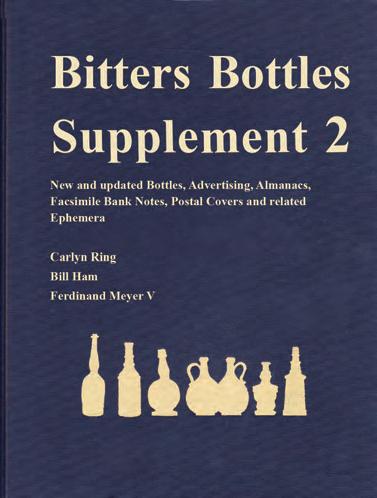
3 minute read
Bitters Bottles Supplement 2 by Bill Ham
By Bill Ham When Bitters Bottles was published in 1998, I thought that it probably included essentially all the various bitters bottles. I was rather surprised when several unlisted bitters bottles were brought into the Antique Bottle and Glass Collector Extravaganza Show at Valley Forge the Labor Weekend in 1998, when the book was released. Collecting information for a supplement was started that weekend, and the first Bitters Bottles Supplement was published in 2004. Since that publication, many more bottles have been discovered, and much more information has become available. This Bitters Bottles Supplement 2 has resulted from that additional cataloging. Collectors are deeply indebted to all those who have worked on this ongoing project of cataloging bitters bottles, going back to Van Rensselaer’s original publications. The cataloging of bitters as a separate category began with J. H. Thompson’s Bitters Bottles published in 1947, which was followed by Works of Art by Jewell Umberger and Ed Bartholomew. The work of Richard Watson in Bitters Bottles published in 1965 was the first to include accurate drawings of the bottles with their embossing. Western Bitters published by Bill and Betty Wilson combined the cataloging of Western brands with historical information on the producers and agents for the products. The work of Carlyn Ring in For Bitters Only, illustrated by Diane Wheaton, published in 1980, combined accurate drawings of the bottles with their embossing with related material and introduced a measurement system for the bottles. Her publication helped bitters become one of the most prized and collected categories of antique bottles. Bitters Bottles Supplement 2 continues building on all the previously published information. The earlier publications listed primarily bottles with the word ‘Bitters’ embossed on the glass. Later books began listing label
Bitters Bottles Supplement 2 soon to Print
Close to 500 pages of new and updated material!
bottles with the word ‘Bitters’ in advertisements, and ephemera. The system of cataloging started by Carlyn Ring was to put the bottles in alphabetical order based on the first word on the panel that had the word ‘Bitters’ embossed. Then, as numbers were given to label only or ephemera identified brands, when bottles of the brand were later found with ‘Bitters’ embossed the previous system of listing with first word on side with ‘Bitters’ embossed often became inconsistent with that of the previous cataloging. Therefore, one should look for a brand not only by the alphabetized first word on the side with ‘Bitters’ embossed but also by the manufacturer or proprietor or any way the brand might be listed.
The index for Bitters Bottles Supplement 2 includes both the Bitters Bottles and the Bitters Bottles Supplement material. With Bitters Bottles Supplement 2, all the previously cataloged material is included in the index, and it also includes much more extensive indexing of the material in the previous books.
Information in Bitters Bottles Supplement 2 has been divided and placed in sections as follows. The top collections in each instance have been accessed for inclusion.
1. Introductory Material 2. New and Updated Cataloging 3. Color Plates (Bitters Bottles) 4. Color Plates (Bitters Postal Covers) 5. Color Plates (Bitters Covers) 6. Color Plates (Facsimile Currency) 7. Color Plates (Shell Cards & Tokens) 8. Index (includes all three Bitters Bottles books)
A work of this nature cannot be complete. Just as previous researchers stopped at some point and presented their work, we believe that the additional information found in this book justifies its now being presented to collectors. There will be additional discoveries, which we leave for future publications. Digital files have already been started for Bitters Bottles Supplement 3.
This massive document has voluminous quantities of highly detailed information. Although it was submitted to extensive review and editing, there undoubtedly will be errors and omissions. Future information and discoveries should now be sent to Ferdinand Meyer V who will continue the cataloging of bitters bottles and related material for possible future publications.
I am very indebted to Ferdinand who has encouraged me in the preparation of this book and made the information on his Peachridge Glass website available for inclusion. He has assisted me with this publication including providing information, research, and editing of the text, and he produced the final layout for publication. Ferdinand also thoroughly indexed all three Bitters Bottles books. Without his help, this book would still be in draft.








